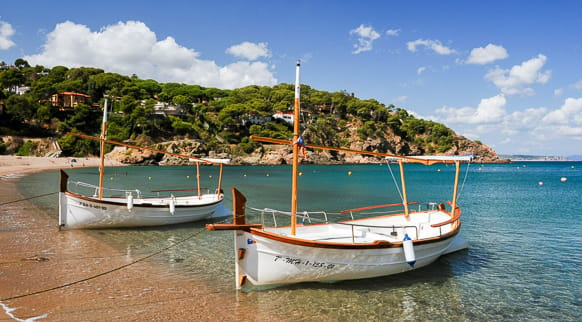ALLIANZ: Costa Brava Travel Guide
Start exploring the Wild Coast of Spain


Because it's one of the most romantic, gorgeous, unspoilt stretches of coast in Europe. Where else, less than two hours' flight from Britain, can you drive or walk alongside rugged pink rocks with the teal-coloured Mediterranean glimmering below, framed by grand, arabesquing pines? You can, of course, on the Cote d'Azur. But essentially what you find on the Costa Brava is the same coastline, a little farther south, generally at a fraction of the price.

Gloriously wild in parts and tastefully manicured in others, the Costa has some of the finest Blue Flag beaches in Europe, broad and sandy stretches to elegant horseshoe bays and secluded smugglers' coves.
You'll also find wonderful, independent hotels and exceptional food. Any lingering associations there may be with egg and chips are well past their sell-by date. Yes, English menus may still be a fixture in the larger resorts on the southerly part of the coast, such as Lloret de Mar, but further north you won't catch a glimpse of them.
In fact this stretch of the coast is a foodie's paradise and Catalonia - where the Costa Brava lies - has one of the highest concentrations of Michelin-starred chefs in Spain, not to mention superb, locally produced wines. Little wonder that this has been the holiday spot of choice for well-heeled Barcelonesas and in-the-know French for years.
The weather is another key factor, and one of the things I most love about living here. Going for a walk along the beach on Christmas day in short sleeves without feeling chilly was a blissful revelation after British winters.
Beyond that there's art, history and outdoor activities aplenty. This is Dalí country and three excellent museums - including the painter's home at Cadaqués - are devoted to him. The Costa is also home to some of the most scenic and important Greco/Roman and Iberian archaeological sites in Europe.

Alternatively, if you just want to enjoy the spectacular surroundings, there are exceptional coastal walks and world-class golf courses, as well as extensive swimming, diving, snorkelling and sailing.
When to go
A decent dose of sunshine is reasonably guaranteed most of the year round. If you're not bound by school holidays and can visit during May, June or September, these are brilliant months to enjoy the joint benefits of warm temperatures and lower hotel rates while avoiding the crowds of July and August.
Having said that, if you've set your heart on perfecting a tan in sizzling heat, high summer is the time to choose. If you do come during those peak months, you'll find the region busy but not over-run, and you can still enjoy relatively secluded beaches without having to knock elbows with half of Europe.
From February to April and October to November the weather is generally pleasant: you might catch springtime electric storms or autumn rains but these don't usually last for many days.
Where to go
If you like the idea of luxuriating on immaculate Mediterranean beaches miles away from the hordes, head for the stretch of coast between Pals beach and Palamos. The genteel horseshoe bays of Llafranc and Calella de Calafrugell are two of the prettiest, whilst at the even daintier Tamariu you can savour plump, grilled sardines yards from the sea. Inland, the walled medieval hilltop town of Begur is a maze of cobbled streets, restaurants and quirky shops.
Know before you go
Flight time: approximately two hours to Girona or Barcelona
Currency: Euro
Further reading: en.costabrava.org
Emergency numbers/contacts: medical, fire and police: 112. Local police: 092
British Consulate in Barcelona: Avenida Diagonal 477, 13a Planta, 08036 Barcelona (00 34 902 109356 or 00 34 913 342194; gov.uk)
Local laws and etiquette
When it comes to tipping: about five per cent for taxis and restaurants, €1 for hotel porters. Bars and cafés don't normally expect tips unless you're sitting at an outdoor terrace, where it's polite to leave €0.30-€0.50.
Keep your passport with you as some shops quite often ask to see it if you're paying by credit card.
If you don't have one, apply for a European Health Insurance Card so you're eligible for state medical treatment, should you need it.

Low season can be an especially good time to visit the Costa Brava as the weather is often still sunny and many hotels have sea view rooms at outrageously low prices. But be aware that some restaurants close for the winter, particularly in Cadaqués.
Download the free Telegraph Travel app to destinations worldwide: itunes.apple.com
Follow Telegraph Travel on Twitter More Telegraph Travel expert guides




